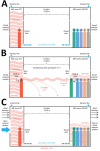Airborne Transmission of SARS-CoV-2 Delta Variant within Tightly Monitored Isolation Facility, New Zealand (Aotearoa)
- PMID: 34965365
- PMCID: PMC8888211
- DOI: 10.3201/eid2803.212318
Airborne Transmission of SARS-CoV-2 Delta Variant within Tightly Monitored Isolation Facility, New Zealand (Aotearoa)
Abstract
In New Zealand, international arrivals are quarantined and undergo severe acute respiratory syndrome coronavirus 2 screening; those who test positive are transferred to a managed isolation facility (MIF). Solo traveler A and person E from a 5-person travel group (BCDEF) tested positive. After transfer to the MIF, person A and group BCDEF occupied rooms >2 meters apart across a corridor. Persons B, C, and D subsequently tested positive; viral sequences matched A and were distinct from E. The MIF was the only shared location of persons A and B, C, and D, and they had no direct contact. Security camera footage revealed 4 brief episodes of simultaneous door opening during person A's infectious period. This public health investigation demonstrates transmission from A to B, C, and D while in the MIF, with airborne transmission the most plausible explanation. These findings are of global importance for coronavirus disease public health interventions and infection control practices.
Keywords: COVID-19; Delta variant; New Zealand; SARS-CoV-2; airborne transmission; coronavirus disease; respiratory infections; severe acute respiratory syndrome coronavirus 2; viruses; zoonoses.
Figures




References
-
- World Health Organization. Naming the coronavirus disease (COVID-19) and the virus that causes it [cited 2021 Dec 14]. https://www.who.int/emergencies/diseases/novel-coronavirus-2019/technica...
-
- Centers for Disease Control and Prevention. How COVID-19 spreads [cited 2021 Dec 14]. https://www.cdc.gov/coronavirus/2019-ncov/prevent-getting-sick/how-covid...
-
- Centers for Disease Control and Prevention. SARS-CoV-2 and surface (fomite) transmission for indoor community environments [cited 2021 Dec 14]. https://www.cdc.gov/coronavirus/2019-ncov/more/science-and-research/surf... - PubMed
Publication types
MeSH terms
Supplementary concepts
LinkOut - more resources
Full Text Sources
Medical
Miscellaneous

